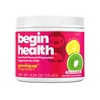What’s the Safe Daily Amount of Magnesium for Kids?
share this article

Magnesium plays a critical role in your kiddo’s development, from helping muscles relax to supporting healthy poops. But with more parents turning to supplements for constipation or sleep support, it’s important to know: How much magnesium is safe for kids?
Here’s what the latest research and expert guidelines say about daily magnesium needs, what forms are best, and how to avoid giving too much.
Why Magnesium Matters for Toddlers and Kids
Magnesium supports over 300 biochemical reactions in the body. In kids, it’s essential for:
-
Healthy digestion and stool regularity
-
Muscle and nerve function
-
Bone development
-
Sleep and relaxation
-
Mood and emotional regulation
Despite its importance, many kids don’t meet their daily magnesium needs, especially those who are picky eaters or eat fewer whole grains, greens, or beans.¹
Recommended Daily Magnesium Intake by Age
The National Institutes of Health (NIH) provides clear guidelines for how much magnesium kids need each day through food and supplements combined. [2]
|
Age Group |
Recommended Daily Intake (RDA) |
|
1–3 years |
80 mg |
|
4–8 years |
130 mg |
|
9–13 years |
240 mg |
These values are based on what’s needed for proper growth and body function—not just what helps with constipation.
What’s the Safe Upper Limit?
In addition to RDAs, experts have set Tolerable Upper Intake Levels (ULs) to define the safe maximum for magnesium from supplements only (not food).
|
Age Group |
Upper Limit for Supplements |
|
1–3 years |
65 mg/day |
|
4–8 years |
110 mg/day |
|
9–13 years |
350 mg/day |
Going over this limit may cause side effects like diarrhea, cramping, or electrolyte imbalances, especially if the magnesium comes from laxatives or high-dose supplements.[2]
Best Magnesium Forms for Kids
If you're supplementing, choosing the right form matters. Here’s what’s considered safest and most effective:
-
Magnesium citrate: Well absorbed and often used to relieve mild constipation
-
Magnesium glycinate: Gentler on the stomach and ideal for sensitive kiddos
-
Magnesium oxide: Less well absorbed and more likely to cause GI discomfort
A supplement like Growing Up Magnesium uses citrate and glycinate together to balance absorption and stool-softening benefits, without harsh laxative effects.
Can You Get Too Much?
Yes, but usually only from high-dose supplements not food.
Too much magnesium from food (like nuts, leafy greens, or whole grains) is extremely rare. But with powders, gummies, or drinks, it’s easy to go over the safe limit without realizing it, especially if using multiple products.
Always check the label for how much elemental magnesium is included per serving and aim to stay within your kid’s age-appropriate limit unless advised otherwise by a healthcare provider.
Summary
Magnesium is a key nutrient for your kid’s gut, sleep, and overall health—but dosing matters. Kids ages 1–8 need between 80–130 mg daily, and supplement amounts should stay below safe upper limits unless directed by a pediatrician. When used correctly, magnesium can be a powerful tool to support regularity and calm—naturally and safely.
















